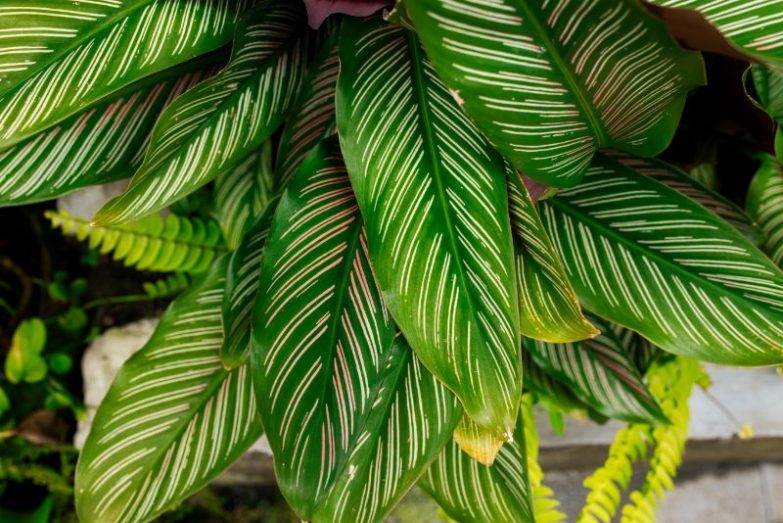Calatheas are stunning plants with amazing foliage, but they can be a bit grouchy if their conditions aren’t met. Unfortunately, they express discontent through those beautiful leaves. Let’s go over the reasons your Calathea leaves are turning yellow and how you can fix the problem.
Why are my Calathea leaves turning yellow? To avoid yellow leaves, Calatheas need bright, indirect light, high humidity, and consistently moist soil. Yellowing leaves can also be caused by stress from overwatering, droughts, temperature extremes, acclimation issues, nutrition, drafts, pests, or old age.
Why Your Calathea Leaves Are Turning Yellow
You love your Calathea and try to give it optimal care – it can be frustrating if it develops yellow leaves in spite of your best efforts. It’s common, though. The plant rather deserves its finicky reputation.
Calatheas leaves turn yellow from stress, and it can happen on the edges, the tips, or all over. Yellowing close to the center of the plant is considered more serious than peripheral coloring. The good news is that, once you’ve solved the issue, Calatheas can be forgiving and will sprout new leaves just as gorgeous as before.
A look at this delicate tropical’s jungle origins reveals why the plant is so demanding. Their native light is bright but heavily filtered; steamy, warm air gently mists the moist organic soil. It’s no wonder proper watering, light, and humidity are so important to the species.
If your Calathea runs into trouble, the way forward is to correct any errors in care without going overboard: no heavy fertilizing, no extra watering, repotting, etc. Trim damaged leaves—they won’t repair themselves, and pruning them won’t harm the plant. Focus on optimal care and let the plant rebound with new growth.
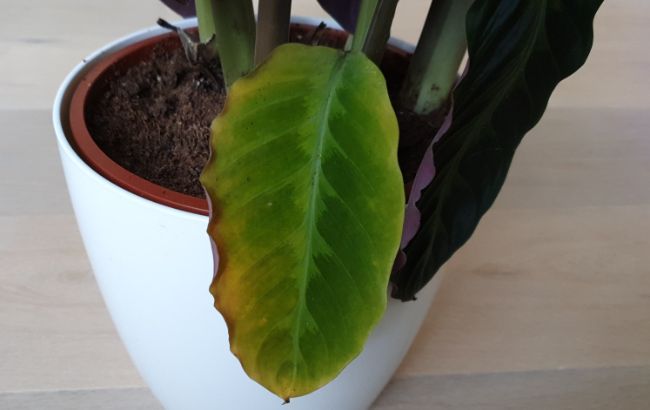
Overwatering
Yellowing leaves is the classic sign of overwatering, and it’s a common cause of Calathea leaves turning yellow. The plant wants consistent, slightly moist soil at all times … however, if you make them sit in a soggy pot, their leaves not only turn yellow, but the roots can be affected.
So, immediately check the soil if you see yellow leaves and also investigate the roots. Make sure there are no mushy, brown areas or a smell of decay that signals potentially deadly root rot.
To find the right watering balance, check their soil regularly. You can’t use a set schedule. Some growers use a moisture meter, but your finger works fine. Only water when the top half-inch of the soil feels dry. Water thoroughly so that it flushes out through the drain holes to carry away excess buildup.
Watering is such a big element of Calathea care that it’s important to consider related factors:
Water Quality – Because they are so sensitive, many growers use rainwater or distilled water for Calatheas. Tap water not only has chlorine and/or chloramine toxins, it may contain minerals and salts that can build up and cause yellow leaves. Consider using one of these cleaner alternatives if your tapwater has a high mineral content. Make sure its room-temperature, too.
Potting Mix – Soil is a key element in providing the right moisture level for Calatheas. You want a well-draining, fluffy medium. The mix should hold moisture but have sufficient aeration so that it never becomes sodden. For more detail about how to make a perfect potting mix, see this article.
Inadequate Drainage – Even ideal soil will become a boggy mess without proper drainage. A sealed container is inadequate – the pot needs holes for water to escape through. A layer of pebbles only reduces soil space and allows water to pool at the bottom: a prelude to Calathea disaster.
If your favored container doesn’t have holes, you can use it as the outer housing of a planting pot with proper drainage. Put a few pebbles in the outer pot’s bottom to keep the inner container high enough that it never sits in water.
Dry Soil
The flip side of the Calathea tightrope is that the plant will be quickly stressed by drought if the soil becomes too dry. Like all stress factors, it can produce yellowing.
Some plants give obvious signs of drooping in dry conditions, but you can’t depend upon a Calathea’s leaves to tell when they’re thirsty. Their animated foliage moves so much in response to temperature and light that it’s not a reliable indicator.
Definitely check the soil moisture if your Calathea closes its leaves in the daytime, but don’t depend upon it as a sign. You must monitor the soil regularly.
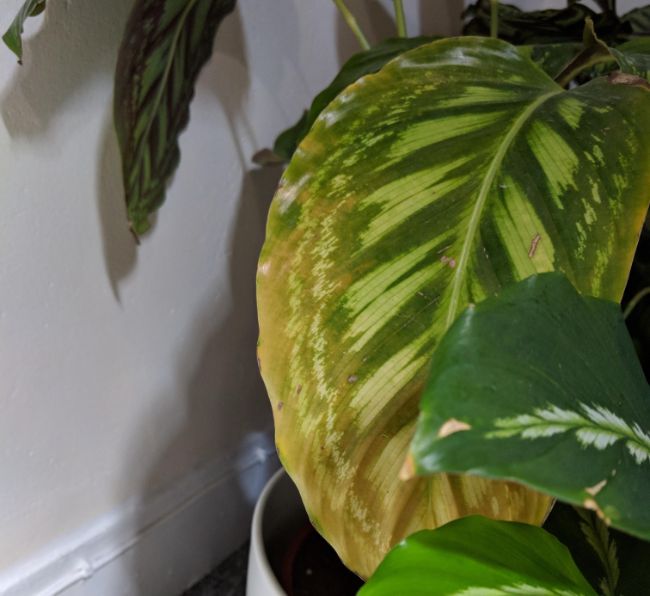
Low Humidity
Like many tropical plants, Calatheas want high humidity to look their best. They may survive low humidity, but the stress can trigger yellowing leaves.
The humidity of their original habitat is 90% or more, but indoor plants tolerate 50% to 70%. The variety with the best reputation for dealing with low humidity is the Rattlesnake Plant (Calathea lancifolia), but they still don’t like dry air.
Here are ways to raise humidity:
• Room Humidifier – If you’re committed to keeping a Calathea collection ready for their close-up, humidifiers are the industrial solution. They are extra work, though, and there are simpler ways to bump the humidity up a few points.
• Grouping Plants – Calatheas make a stunning tropical collection, and keeping them together may increase local humidity a small amount. Don’t crowd them too closely, though. Ensure good air flow, and watch for pests that can quickly infiltrate a tightly bunched group.
• Water-filled Trays – You can modestly increase local humidity through evaporation. Place water trays near your plants or underneath pots using pebbles to raise the container above the water line. One trick is to put upturned seashells on the soil to catch water and act as tiny reservoirs under the leaves.
• Misting – Though misting is too transient to make a big difference in overall humidity, some growers still feel it benefits their Calatheas. Even if misting doesn’t do much for overall humidity, it may give the plant a little boost without burdening the soil with more water.
To avoid leaf spots, it’s a good idea to use the same conditioned water you use for watering. Only mist if the plant has good air flow around it; otherwise, it can encourage fungal issues.
Incorrect Lighting
A Calathea’s active leaves are sensitive to changes. Low light or direct sun can cause yellow leaves.
Calatheas like eight hours of bright indirect light a day. Green and white varieties can lose their variegation in low light; Red Calatheas tend to do the best in lower light. A sunny eastern exposure can work, but provide sheer curtains or other protection against direct sun in a south- or west-facing window.
You can also just move the plant further away. Be aware that every foot from the window drops the light intensity significantly. Two or three feet is usually fine.
Acclimation
It’s an old story. You fall in love with a Calathea and bring it home. You water it carefully, place it in ideal light, give it a humidifier … and its leaves start turning yellow.
Don’t toss your new love on the compost pile just yet. It’s not necessarily you: just changing location can stress this plant. Calatheas move their leaves in a daily cycle – changing the light source can trigger a foliage pity party. Changes in temperature and humidity may subtly add to their stress.
Double-check the conditions and give the plant some quiet time to adjust. With Calatheas, a bit of closely watched neglect can work wonders.
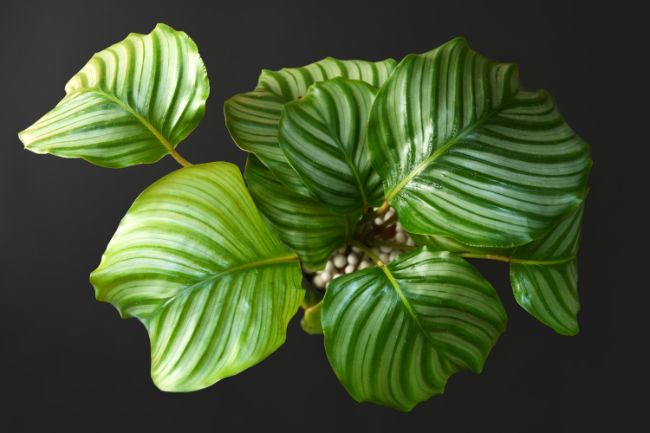
Temperature Extremes
To avoid yellowing leaves, Calatheas need to stay at a temperate range between 62ºF (16ºC) and 81ºF (27 °C). They don’t tolerate cooler temperatures, and even a short dip can cause problems. Quick changes in temperature also stresses them out.
Another complication is that Calatheas don’t like space heaters or any radiating heat source. They can be a struggle to keep happy over a cold winter.
Fertilization Issues
Calatheas don’t require heavy fertilization. Overfeeding can cause yellow leaves and other issues. They can develop yellowed or pale foliage from undernutrition too, but it’s less common.
A light application of a balanced fertilizer at half-dilution each month during the growing season is generally sufficient. Some growers only apply in spring and late summer.
Pro Tip: One gentle organic regimen is to add a teaspoon of kelp fertilizer to a half-gallon of water (preferably distilled). Use this mixture when watering once a month. Don’t pour in the whole half-gallon at once; it should last for some time.
Remember that fertilization is not medicine! It’s only for healthy plants that are actively growing. If your Calathea turns yellow after a feeding, increase the dilution and/or reduce the frequency.
Flushing The Soil
Fertilizer residues can build up in the soil and cause yellowed or lackluster foliage. Partial watering or “topping off” contributes to this, so always water until a stream exits the drainage holes.
To keep the soil fresh, flush it every few months by letting clean water run through the drainage holes for an extra minute or two at watering time. Let the excess drain completely, and don’t rewater until the soil has properly dried.
Caught In A Draft
Another factor that can cause yellowing leaves is a draft. Keep your Calathea protected. Good air circulation is healthy, but a directed stream of cold or hot air gives them stress.
Pests And Diseases
Calatheas are especially prone to spider mites, but they can also get other common houseplant pests like aphids, mealy bugs, and scale. Infestations can cause yellow or stunted foliage.
Spider mites like dry conditions, so their appearance can be a warning that the environment isn’t as moist as Calatheas prefer. Misting might help, but a weekly shower knocking all the dust and bugs off the plant is more effective. Give the plant its wash at watering time to avoid overwetting the soil.
Horticultural oils and insecticidal soaps are effective, but follow-up treatments are needed to get pests under control.
Read my guide to identifying, treating and preventing common houseplant pests for more info.
A common disease that affects Calatheas is a soil-borne fungus called fusarium. It causes yellowing and wilting, and the stem veins can turn brown. A copper fungicide is a limited treatment, but the solution is to carefully wash the soil from the roots, dispose of the medium, sterilize the container, and start with a fresh, pasteurized mix. Fair warning: This will not make the plant happy.
A more deadly plague is Cucumber Mosaic Virus. Calatheas don’t die of it, but they can spread the disease to other plants. The virus creates jagged, splotchy yellow streaks in the leaves. The only choice is to safely discard the plant and the soil, and sterilize the pot.
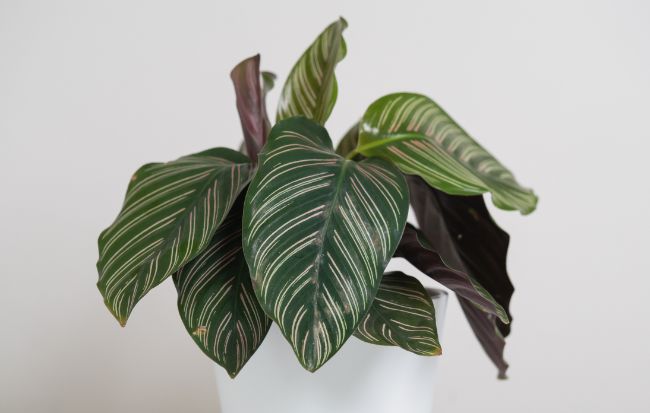
Repotting Recovery
Repotting can be hard on your Calathea. Happily, they don’t mind being slightly rootbound and generally don’t need repotting more than once every two years.
Pro Tip: It’s time to pot up your Calathea is if it needs to be watered more than twice a week.
It can be tempting to repot a new purchase, but it’s seldom a good idea. Even if the plant could use better soil or a larger pot, wait until your Calathea has acclimated to the new environment. One stress at a time.
Aging Foliage
The plant loses lower leaves as they grow older. A mature leaf deteriorating from age won’t recover, so you can remove them as part of regular pruning.
This is one cause of calathea leaves turning yellow you cannot fix, so don’t worry. As long as fresh growth is healthy, you’re on the right path.

